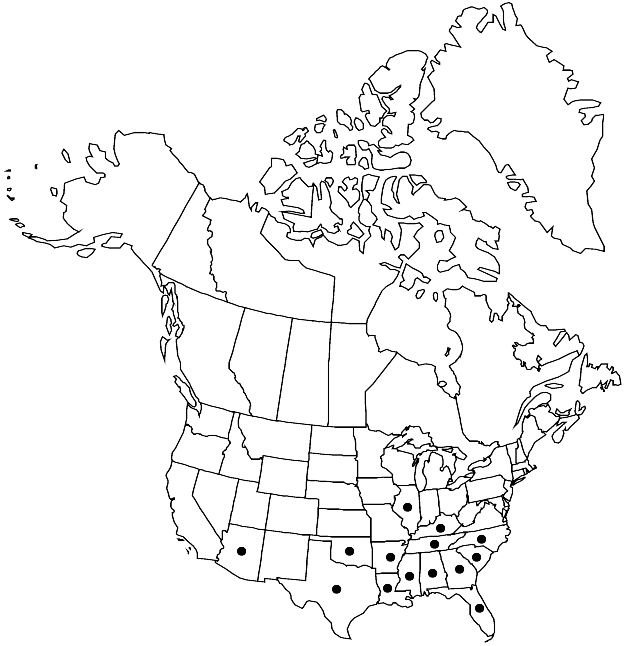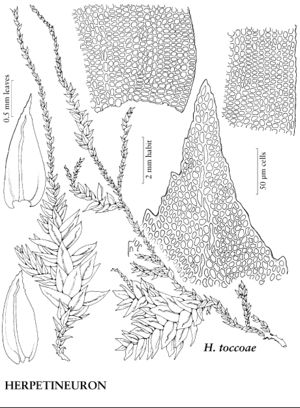Difference between revisions of "Herpetineuron toccoae"
Beih. Bot. Centralbl. 19(2): 127. 1905.
FNA>Volume Importer |
imported>Volume Importer |
||
| (3 intermediate revisions by 2 users not shown) | |||
| Line 9: | Line 9: | ||
|special_status={{Treatment/ID/Special_status | |special_status={{Treatment/ID/Special_status | ||
|code=F | |code=F | ||
| − | |label= | + | |label=Illustrated |
}} | }} | ||
|basionyms={{Treatment/ID/Basionym | |basionyms={{Treatment/ID/Basionym | ||
|name=Anomodon toccoae | |name=Anomodon toccoae | ||
|authority=Sullivant & Lesquereux | |authority=Sullivant & Lesquereux | ||
| + | |rank=species | ||
|publication_title=in W. S. Sullivant, Musc. Hepat. U.S., | |publication_title=in W. S. Sullivant, Musc. Hepat. U.S., | ||
|publication_place=240. 1856 | |publication_place=240. 1856 | ||
| Line 40: | Line 41: | ||
-->{{#Taxon: | -->{{#Taxon: | ||
name=Herpetineuron toccoae | name=Herpetineuron toccoae | ||
| − | |||
|authority=(Sullivant & Lesquereux) Cardot | |authority=(Sullivant & Lesquereux) Cardot | ||
|rank=species | |rank=species | ||
| Line 53: | Line 53: | ||
|publication title=Beih. Bot. Centralbl. | |publication title=Beih. Bot. Centralbl. | ||
|publication year=1905 | |publication year=1905 | ||
| − | |special status= | + | |special status=Illustrated |
| − | |source xml=https:// | + | |source xml=https://bitbucket.org/aafc-mbb/fna-data-curation/src/2e0870ddd59836b60bcf96646a41e87ea5a5943a/coarse_grained_fna_xml/V28/V28_998.xml |
|genus=Herpetineuron | |genus=Herpetineuron | ||
|species=Herpetineuron toccoae | |species=Herpetineuron toccoae | ||
Latest revision as of 21:39, 5 November 2020
Stems (1–)2–4 cm, (0.2–)0.9–1.3 mm thick, terete-foliate when dry, branching pattern often of several orders of successive branching, in stepwise fashion. Branch leaves involute in tubular fashion when dry, 1.8–2.8 × 0.5–1.2 mm; base broadly decurrent; marginal teeth of 1–several cells; costa sinuous in distal 1/3. Perichaetia on youngest branches, leaves 1.5–2.2 mm, apex subulate, subula flexuose, often somewhat crispate, laminal cells smooth throughout. [Capsule urn (1.7–)2–2.8 mm; stomata at base; annulus well differentiated; exostome teeth 0.5 mm; endostome segments 0.2–0.3 mm. Spores densely papillose]
Habitat: Tree bases, rock, temperate deciduous forests
Elevation: m oderate elevations
Distribution

Ala., Ariz., Ark., Fla., Ga., Ill., Ky., La., Miss., N.C., Okla., S.C., Tenn., Tex., Mexico, West Indies (Dominican Republic), Central America (El Salvador, Guatemala, Honduras, Nicaragua), South America (e Brazil), e, se Asia, w, s Africa (South Africa, Tanzania), Pacific Islands (New Caledonia, Papua New Guinea).
Discussion
No sporophytes have been found in the flora area; the description is based on sporophytes from China and Japan.
Selected References
None.
